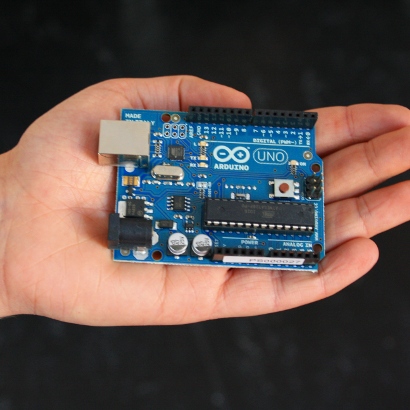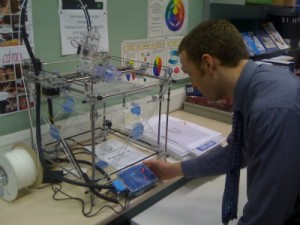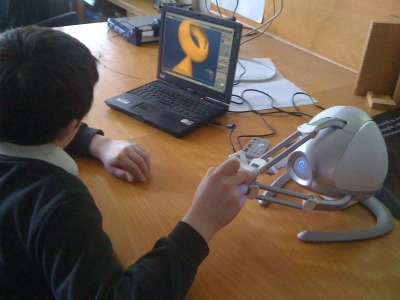

Consolarium blog
Actually, that should be “If they build, they will come….”
Build what though? Enter Arduino.
Arduino is an open-source electronics prototyping platform based on flexible, easy-to-use hardware and software. It’s intended for artists, designers, hobbyists, and anyone interested in creating interactive objects or environments.

I have been playing around with arduino for a while now and on friday 11th March I had the opportunity to attend an arduino work shop for schools, thanks to Steve Bunce at Vital.
What strikes me about Arduino is the opportunities if offers to link up subjects in the context of CfE. Not only can our learners be offered the opportunity to learn to program, but can get some physical hands on time by building a device, learning about resistors, actuators, transistors, motors and a number of other electrical and mechanical devices. There are even soft Arduino components (such as the Lilypad) that allow learners to build electronic clothing. A quick search on Youtube or Vimeo for Arduino will give you a flavour of the types of projects that can be built.
Make Magazine is a great resource to get some Arduino inspiration and starter tips.
The Consolarium have bought some Arduino starter kits and are working with Braeview Academy in Dundee to see how effective it can be within the curriculum.
*Guest post from Stuart Meldrum at Hawick High School who is involved with our rapid prototyping initiative.
“Cool sir! That looks amazing!…but what is it?”
 That is generally the reaction from pupils (and staff) when they first set eyes on the RapMan currently sitting in my classroom. This fantastic monster looks like it has been pieced together with whatever spare parts were lying around the workshop and that isn’t actually too far from the truth. The kit that LTScotland have provided to three schools was essentially a thousand piece jigsaw, where the parts are all standard components like nuts, bolts, and washers, with some laser cut acrylic sheets thrown in. This meant that a lot of my time was spent piecing it all together, this is not a quick task! There is a prebuilt version available for quite a bit more cash.
That is generally the reaction from pupils (and staff) when they first set eyes on the RapMan currently sitting in my classroom. This fantastic monster looks like it has been pieced together with whatever spare parts were lying around the workshop and that isn’t actually too far from the truth. The kit that LTScotland have provided to three schools was essentially a thousand piece jigsaw, where the parts are all standard components like nuts, bolts, and washers, with some laser cut acrylic sheets thrown in. This meant that a lot of my time was spent piecing it all together, this is not a quick task! There is a prebuilt version available for quite a bit more cash.
For the uninitiated the RapMan is one example of a Rapid-Prototyper. This essentially means that it is a machine that can print in 3 dimensions, but instead of leaving a trail of ink the RapMan has a head that can move in two directions and pulls though a filament of plastic, heating it as it moves. The melted plastic is trailled over a bed and a 2D shape is laid out. Then the bed is lowered and the head starts leaving another trail on top of the first. Over time and successive layers the melted plastic fuses together to build up a 3D shape.
For years in Design and Technology departments we have been drawing and designing things in 3D using CAD software but now we have an affordable method or realising these designs. Normally the cost of this sort of machine puts it well out of reach of schools.
Now that our RapMan is up and running in Hawick High School we have loads of ideas as to how we could start to use it in our courses. It lends itself naturally to Product Design where pupils have to create models of their designs, but it fits in all the way down the school too. Also, now that Computer Aided Manufacture is explicitly mentioned in the Level 3 and Level 4 Outcomes and Experiences (TCH 3.13 and TCH 4.15) schools will be increasingly looking to use this technology.
Listen to Stuart’s take on the challenges that he has faced in trying to get the rapid protoyping kit up and running in Hawick High School.
Although we are heavily focused on game based learning and games design at the Consolarium our remit also includes exploring other emerging technologies and how these can impact on teaching and learning. To this end we are currently working with schools in Argyll & Bute, Scottish Borders and Edinburgh City to explore how rapid prototyping kit might be able to play a part in the Design & Technology curriculum.
 What this kit allows us to do is create 3D objects that can then be ‘printed’ in 3D form via the Rapman. This could allow you to create piece of jewellery for example on the computer, in 3D form, and for this to be printed out in 3D form.
What this kit allows us to do is create 3D objects that can then be ‘printed’ in 3D form via the Rapman. This could allow you to create piece of jewellery for example on the computer, in 3D form, and for this to be printed out in 3D form.
We purchased three sets of kit from Anarkik 3D that would enable us to begin this work. This kit includes the Falcon 3D Mouse, the Rapman 3D printer and the Cloud 9 software. The Rapman 3D printer can be purchased fully assembled or in flat pack. Obviously the costs are less for the flat packed version.
I visited Islay High School in Argyll & Bute recently where I met with Ian Stuart who is looking to integrate this kit in to the Design & Tech experiences of his pupils. The day that I arrived I saw the pupils using the software and the 3D mouse to create a pendant that could be attached to a necklace. The school is still in the very early stages of getting to grips with this kit and over the past few months it is fair to say that it has faced some challenges particularly in relation to the construction of the flat-packed Rapman printer. Their experiences to date were captured in this chat with Ian Stuart.
Transcript of discussion with Ian Stuart
Even though it is clear that the flat packed option of the Rapman 3D printer does mean an investment of time and effort in order to build it I have to say that what I saw at Islay HS suggests that this kit can really play a part in pupils experiences of Product Design and Computer Aided Manufacture. Some of the pupils’ designs were rather impressive and their feedback about using the Falcon 3D mouse was very positive.
We will follow up and report on the experiences of Islay HS with this exciting resource.
More
Find us on